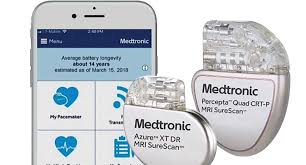Up-and-coming gene therapy for blood disorders and a new class of medications for cystic fibrosis. These are just a few of the many new medical innovations changing healthcare, according to the Cleveland Clinic.
In conjunction with the 2020 Medical Innovation Summit, the Cleveland Clinic announced the Top 10 Medical Innovations for 2021. This is the 18th year of the Summit.
The Best in Medical Innovations
The list of breakthrough technologies was selected by a committee of Cleveland Clinic subject-matter experts. Led by Will Morris, M.D., executive medical director for Cleveland Clinic Innovations, and Akhil Saklecha, M.D., managing director of Cleveland Clinic Ventures.
Here are the Top 10
Here, in order of anticipated importance, are the Top 10 Medical Innovations for 2021:
1. Gene Therapy for Hemoglobinopathies
Hemoglobinopathies are genetic disorders affecting the structure or production of the hemoglobin molecule. This is the red protein responsible for transporting oxygen into the blood. The most common hemoglobinopathies include sickle cell disease and thalassemia. Which combined affect more than 330,000 children born worldwide every year. Sickle cell disease is prevalent in the Middle East, South Asia, Africa, Latin America, and the Mediterranean. According to the Centers for Disease Control and Prevention (CDC), traits for thalassemia are more common in people from Mediterranean countries and in people from Asia, Africa, and the Middle East. The latest medical innovation in hemoglobinopathies has brought an experimental gene therapy, giving those who have the disorder the potential ability to make functional hemoglobin molecules. This reduces the presence of sickled blood cells or ineffective red blood cells in thalassemia to prevent associated complications.
2. Novel Drug for Primary-Progressive Multiple Sclerosis
In individuals with multiple sclerosis (MS), the immune system attacks the fatty protective myelin sheath that covers the nerve fibers – causing communication problems between the brain and the rest of the body that can result in permanent damage or deterioration and eventual death. Approximately 15 percent of people with MS experience a disease subset known as primary-progressive, characterized by gradual onset and steady progression of signs and symptoms. This medical innovation has been FDA-approved and is a therapeutic monoclonal antibody with a novel target is the first and only MS treatment for the primary-progressive population.
3. Smartphone-Connected Pacemaker Devices
Implantable devices like pacemakers and defibrillators deliver electrical impulses to the heart muscle chambers to contract and pump blood to the body. They are used to prevent or correct arrhythmias – heartbeats that are uneven, too slow or too fast. Remote monitoring of these devices is an essential part of care. Traditionally, remote monitoring of this device takes place through a bed-side console that transmits the pacemaker or defibrillator data to the physician.
 Though millions of patients have pacemakers and defibrillators, many lack a basic understanding of the device or how it functions and adherence to remote monitoring has been suboptimal.
Though millions of patients have pacemakers and defibrillators, many lack a basic understanding of the device or how it functions and adherence to remote monitoring has been suboptimal.
Bluetooth innovation
Bluetooth-enabled pacemaker devices can remedy these issues of disconnection between patients and their cardiac treatment. Used in conjunction with a mobile app, these connected devices allow patients greater insight into health data from pacemakers and transmit health information to their physicians.
4. New Medication for Cystic Fibrosis
According to the Cystic Fibrosis Foundation, more than 70,000 people worldwide are living with cystic fibrosis (CF). It is a hereditary condition characterized by thick, sticky mucus that clogs airways and traps germs, leading to infections, inflammation and other complications. CF is caused by a defective cystic fibrosis transmembrane conductance regulator (CFTR) protein.
FDA approved medical innovation
A class of drugs called CFTR modulators correct the protein’s action, but medications developed prior to last year had only been effective in a subset of people with certain mutations. The new combination drug, FDA approved in October 2019, provides relief for patients with the most common CF gene mutation (F508 del) – estimated to represent 90 percent of individuals living with the disease.
Medical Innovations Save Lives
5. Universal Hepatitis C Treatment
Classified as a “silent epidemic” by the CDC, hepatitis C infection can lead to serious, life-threatening health problems like liver failure, cirrhosis and liver cancer. With no vaccine for the virus, patients have been limited to medication, but many treatments were accompanied by adverse side effects or only effective for certain genotypes of the disease. A new, approved fixed-dose combination medication has vastly improved hepatitis C treatment. More than 90 percent effective for hepatitis C genotypes one through six, the therapy represents an effective option for a wider scope of patients.
6. Bubble CPAP for Increased Lung Function in Premature Babies
Underweight and frail, babies born prematurely often require specialized care – including ventilation for those with infant respiratory distress syndrome (IRDS). For IRDS, infants are commonly administered surfactant during mechanical ventilation, a practice that can cause lasting lung injury in preterm infants and contribute to the development of chronic lung disease.
Non-invasive medical innovation

Unlike mechanical ventilation, b-CPAP is a non-invasive ventilation strategy – delivering continuous positive airway pressure to newborns to maintain lung volumes during exhalation. The oscillating, rather than constant pressure, plays a role in its safety and efficacy, minimizing physical trauma and stimulating lung growth when administered over a prolonged period.
7. Increased Access to Telemedicine through Novel Practice and Policy Changes
COVID-19 saw increased adoption of telemedicine practices as clinicians needed to conduct patient visits online. An increasingly virtual care model and increased consumer adoption came by way of fundamental shifts in policy in many countries. In the U.S., for example, since March, state and federal regulators have moved quickly to reduce barriers to telehealth, understanding that these new tools can speed access to care while protecting healthcare workers and community members. These measures opened the floodgates for telehealth, allowing for new programs and the expansion of existing networks.
8. Vacuum-Induced Uterine Tamponade Device for Postpartum Hemorrhage
Characterized as excessive bleeding after having a baby, postpartum hemorrhage is a devastating complication of childbirth, affecting one to five percent of women who give birth. Mothers experiencing postpartum hemorrhage may require blood transfusions, drugs which may cause dangerous side effects, long uncomfortable procedures, and even emergency hysterectomy with loss of fertility. Non-surgical interventions directed at the site of bleeding have been limited to balloon devices that expand the uterus while compressing the site of bleeding. But the newest advancement is that of vacuum-induced uterine tamponade – a method that uses negative pressure created inside the uterus to collapse the bleeding cavity causing the muscle to close off the vessels. The vacuum-induced device represents another minimally invasive tool for clinicians as they treat the complication and provides a low-tech solution that is potentially translatable to developing countries with low resource availability.
9. PARP Inhibitors for Prostate Cancer
About one in nine will be diagnosed with prostate cancer in their lifetime. While there has been progress in the last decade, the disease is the sixth leading cause of cancer death among men worldwide, according to the American Association for Cancer Research. PARP inhibitors – pharmacological inhibitors for cancer treatment – block proteins called PARP that help repair damaged tumor DNA in people with BRCA1 and BRCA2 gene mutations. Though known for their success in women’s cancers, two PARP inhibitors have been demonstrated to delay the progression of prostate cancer in men with refractory cancer and DNA repair pathway mutations. Both were approved for prostate cancer in the U.S. in May 2020.
10. Immunologics for Migraine Prophylaxis
Migraines affect an estimated one billion people worldwide, according to the Migraine Research Foundation. For some time, multi-purpose drugs like blood pressure medications, antidepressants, anti-seizure drugs and Botox injections have been used to prevent attacks. While not developed specifically for migraines, these methods have been met with mixed results. In 2018, new medications were developed to help head off migraine pain. The class of drugs works by blocking the activity of a molecule called calcitonin gene-related peptide (CGRP), which spikes during a migraine. Actively prescribed in the U.S. in 2020, this new FDA-approved class of medications is the first to be specifically designed for the preventive treatment of migraines, marking a new era of migraine therapeutics.
Cleveland Clinic Medical Innovations for 2021
At next year’s Medical Innovation Summit, in addition to the annual Top 10 list, Cleveland Clinic will present a new award in honor of its rich history of innovation and advancements in healthcare delivery. The inaugural prize will be awarded to a team, organization or individual who has made a significant contribution to healthcare delivery with a focus on one or more defined areas. Details will be released in early 2021.
Read more
Telemedicine is becoming ever more prevalent in our lives. Here’s what you need to know. Click here.





![women [longevity live]](https://longevitylive.com/wp-content/uploads/2020/01/photo-of-women-walking-down-the-street-1116984-100x100.jpg)










